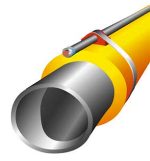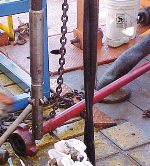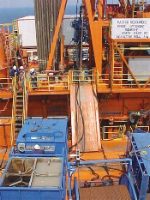DeepStar technology achievements
DeepStar technology achievementsAn overview of the seven-year-old industry initiative to develop new deepwater technology: Highlights of its progress and where it’s headedPaul R. Hays, Texaco Inc.; and James E. Chitwood, Chitwood Engineers, Houston
This review tells how the group has done so far from Phase I through Phase IV, with discussions on background and evolution of the technology, and specific contributions and successes of the group’s several working committees. These committee reviews include: Vessels, Mooring and Risers; Subsea Equipment & Pipelines; Flow Assurance; and Drilling. Also noted are DeepStar’s new role in interfacing with U.S. Regulators and an update on full-scale flow assurance testing at the Rocky Mountain Oilfield Test Center in Wyoming. Introduction Since DeepStar’s inception in 1992, the Program has progressed from a $550,000 conceptual study of the feasibility of extended-reach subsea tiebacks to a focus on developing generic deepwater technology. DeepStar Phase IV began in 1998 and now has a two-year budget of about $14 million for its work studies. Phase IV comprises 23 participating oil companies and about 45 vendor companies contributing to a deepwater technology development effort. DeepStar emphasizes deep water in more areas than the Gulf of Mexico. A significant component of the research done is generic and has worldwide application. Planning for Phase V is presently underway. As with Phase III, Phase IV emphasizes testing with a goal of expediting technology deployment. Committees focus on Regulatory, Flow Assurance, Subsea Equipment, Vessels, Mooring, Risers, Drilling & Completions, Reservoir Engineering and MetOcean (Gulf of Mexico Inflow Measurement) issues. The continued cooperative research efforts between DeepStar, industry and government agencies reap many benefits. Technology Evolution Through Deepstar The DeepStar program is now moving into its seventh year as an ongoing joint industry effort. In 1992, Texaco sought to pursue development of extended-reach subsea tiebacks from the deepwater Gulf back to existing shelf infrastructure. A quick view of water depth contours indicated a large section of the deepwater Gulf extending out to 6,000 ft could be readily produced with very few shallow water (» 600 ft WD) regional processing centers, if the components of extended-reach technology were feasible. Since DeepStar kicked off in 1992, very few extended-reach tiebacks have been initiated — this provides testimony to their difficulty. Shell’s 65-mi Mensa tieback is a case in point. Although hydrates are a concern, the field is essentially a gas field. Whereas, for the more general case of viscous, paraffin-laden crudes typically encountered in the Gulf, near-term development solutions still appear to give primacy to surface-based completions. As evidence, consider the Compliant Towers (Amerada Hess’ Baldpate, Texaco’s Petronius), Spars (Oryx, now Kerr-McGee’s Neptune, and Chevron’s Genesis), and TLPs ranging from those such as Auger (’93–’94), Mars (spring ’96), Ram-Powell (spring ’97), Ursa (early ’99) and Brutus (planned for 2001) to the mini-TLPs of British Borneo that have been initiated or completed since 1992. And several subsea systems have been installed, e.g., BP’s Pompano and Troika, Shell’s Popeye, Exxon’s Diana and, more recently, Texaco’s Gemini 28-mi tieback that will go onstream later this summer. The point is that, with the exception of Shell’s Mensa, these are not the long-offset (40 to 60-mi) tiebacks originally envisioned in the classic DeepStar design basis. Neither are these very-large reservoirs that are independently supporting in-field facilities. Therefore, DeepStar participants quickly learned that they had to study more than extended-reach tiebacks if they wanted DeepStar technology development efforts to contribute meaningfully to future prospects. The organization began looking at produced fluids (flow assurance), subsea equipment (including pipelines, flowlines and umbilicals); and it considered vessels, mooring and riser systems, as well as drilling and completion issues. Later, in Phase IIA, the Program added a reservoir engineering committee and focused its studies on public domain information for those reservoir and performance characteristics common to the deepwater Gulf of Mexico. DeepStar has grown to fulfill a role lacking in isolated Joint Industry Projects (JIPs). These groups tend to have good focus on targeted objectives. But what if you don’t know precisely what is needed? What is the process of moving from concept to execution of a given technology effort? Formation of an individual JIP is typically an arduous and time-consuming process for the sponsor. DeepStar is a forum of those broadly interested in advancing deepwater technologies and which are involved collectively in forming the JIP. The process is time consuming, but many issues are advanced in parallel and we gain much from this collective intellectual exercise. The organization does provide a backbone, continuity of effort and focus to develop a broad base of technology applicable to deep water. Technology Deployment Following are a few examples of technology developed within DeepStar as it matures and contributes toward reducing the risk and cost of deepwater production development systems. Vessels, Mooring and Riser Committee work. We unsuccessfully tested vertically loaded drag embedment anchors in Phase IIA. Then in August 1996, as part of Phase III, and as a benefit of DeepStar’s continuity, we successfully deployed these anchors in shallow water. Anchor manufacturers’ participation in the tests have helped ensure continued improvements in these economic alternatives to drilled and grouted piles for taut leg mooring systems. A two-year test of a polyester mooring line concluded in November 1998. The system, deployed in 3,000-ft WD near Shell’s Auger TLP was instrumented for data recording and retrieval. Now in Phase IV, a synthetic mooring postmortem is underway to help us learn how well we can predict the behavior of this potential economic alternative to conventional chain and wire rope mooring systems. The polyester mooring line is being tested for chemical degradation, as well as wear and tear during deployment and service, Fig. 1.
This work and other work with synthetic moorings is being captured in a "Guide for synthetic ropes in offshore mooring applications" that is currently in preparation. The vessels committee is filling another industry need by leading an effort with API to produce a draft API RP ZFPX "Planning, designing & constructing floating production systems." These standards provide useful tools for performance-based regulations. Subsea Equipment & Pipelines Committee. An early vision of DeepStar was to progress components of deepwater subsea systems to deployment. The program’s progression has definitely been in the direction of more testing. The evolution has been gradual, and the progression has been steady. We cite as evidence, the offshore deployment of an electrically heated pipe system, Fig. 2. Alcatel and Thermotite finished a six-month test of a resistively heated pipe system in March 1999. The pipe system was tested in a Norwegian fjord. Alcatel is currently compiling data from the tests and preparing to lab test pipe coatings. The work is cumulating into a design guide complete with supporting software
DeepStar has come this far in incremental steps. Early in Phase II we focused on static (seafloor) metal-tube umbilicals which were later adapted and qualified for dynamic (riser) service in Phase III. They are now routinely used in developments. In Phase III, the Subsea Committee filled a gap in its work on deepwater pipeline repair by giving attention to pipeline contents containment during line repair operations. This effort built on previous work which examined both bottom-based and surface-based repair techniques. This ability to repair deepwater pipelines has led to formation of a work group developing a consortium to stockpile critical deepwater-pipeline-repair equipment. Qualification testing has been completed in Phase III for control valves, to provide reliable and consistent subsea distribution of chemicals and reduce long-offset umbilical costs. These field tests identified areas of improvement in the tested valves and established a testing facility with high standards for new distribution valves. Deepwater pigging is important technology being investigated to improve performance and reduce production system costs. Work includes:
Subsea well intervention has been studied in most DeepStar phases. Intervention technology is a significant deepwater field operating cost component. New methods for performing well intervention, and the required surface support vessels, have been evaluated. Current work is investigating reduced-bore completion and marine riser systems. A low-cost well service system is expected to result from this study. Flow Assurance Committee. Working with chemical vendors, a compatibility matrix of generic oilfield chemical families and concentrations has been developed. Many chemicals used to treat production are incompatible; if mixed, they may gel or crystallize, resulting in plugged umbilicals or injection ports. This matrix provides guidance regarding viable chemical mixtures for dosing a well’s production. A 1997 field test successfully demonstrated the technique of removing hydrate blockages in flowlines by lowering pressure from only one side of the blockage. This work has developed methods and procedures ensuring an operator that single-sided pipeline depressuring of hydrate plugs can be accomplished safely in a controlled manner. Further work continues to improve hydrate plug decomposition predictive software and plug location methods. A Phase III lab test loop demonstrated the feasibility of deploying coiled tubing to remove paraffin blockages in flowlines at distances of over five miles from either side of the pipeline entry point. A successful demonstration in lab apparatus was achieved. In the initial field applications for Agip and Unocal, this technology did not work as smoothly as had been expected; however, each attempt in the field moves the industry up the learning curve. Since the initial field applications with their lessons learned, ten operators have utilized and benefited from this technology. These operators include: Exxon, Mobil, Vastar and Texaco. Fig. 3 and 4 depict Vastar’s use of AMBAR’s Startac Pipeline Remediation system.
Several other DeepStar participants are considering this technology to remediate their currently plugged lines. The organization continues to look for plug remediation technology improvements. This includes alternate blockage removal methods and methods to safely and efficiently clear occluded (but not completely blocked) lines. Tests with coatings to minimize or prevent adhesion of wax deposits on pipe walls have not proved to be as successful as hoped. Only by pursuing each path to its logical conclusion with a comprehensive testing program do we have the ability to find efficient deepwater production solutions. Drilling Committee work. Deepwater drilling in the Gulf of Mexico (and other parts of the world) sometimes encounters shallow, geopressured water aquifers which produce large quantities of water and may washout well foundations while drilling top-hole portions of the well. DeepStar created a database of shallow water flow (SWF) experiences and researched, with DeepStar companies, solutions to manage this problem. Some of these are currently utilized while others (like the deep-driven, top-hole casing method) approach the field trial stage. Drilling in deep water with typical marine drilling equipment required improved predictive well control software tools. This challenge has been addressed, and improved predictive well control software is now available. Additional software modules are being added to improve the range of problems that may be addressed. In concert with the National Institute of Standards and Technology (NIST), DeepStar has fostered development of a composite drilling riser (an initial gleam in our eyes), to the stage that a 25-ft pup joint will be deployed on a working drilling rig offshore. The 1998 phase of this $4.8-million project was lab testing of the joint; the late-1999 phase will be the joint’s field use. Vendors are now able to deliver products such as 10,000-ft composite risers and composite choke and kill lines for drilling vessels as a result of this project. Interface With U.S. Regulators Even though DeepStar’s focus is on commercially viable technology, the project also recognizes that regulators can either advance or delay new technology deployment. Therefore, the DeepStar 4100 Regulatory Committee functions as a liaison between industry and regulators, such as the Minerals Management Service (MMS) and the United States Coast Guard, to establish a cooperative effort to facilitate approval of technology deployment. There have been many successful cooperative projects between DeepStar and Regulators. One early milestone achievement was DeepStar/MMS development of a Deepwater Operations Plan (DWOP) for Subsea Developments and Floating Production Systems. These documents were matured by the MMS and distributed without substantive alterations as "Notice to Leasees" for all Gulf of Mexico leaseholders. DWOP submission is now the principal element in securing approval for developments. The most significant ongoing DeepStar regulatory committee work effort is the $1.3 million Environmental Impact Study (EIS) for a generic FPSO/FPS for the Gulf of Mexico. In cooperation with MMS, DeepStar has agreed to sponsor the EIS with a grant given to the MMS. The MMS will oversee organization, contracting and completion of the EIS; DeepStar provides the funds and technical assistance. The MMS has awarded the EIS contract to Ecology and Environment Inc. Flow Assurance Challenges Recognized early in DeepStar was the significant progress needed within flow assurance before subsea, extended-reach tiebacks became common in deepwater field developments. DeepStar’s flow assurance committee has matured several technologies to the point of field-scale testing. These include methods to prevent, mitigate, as well as remediate hydrate and paraffin deposits. Without these new technologies being field qualified, more costly developments utilizing less efficient conventional technologies will be used. In Phase IV, the DeepStar Flow Assurance Committee started a fast-track program to construct, commission and test a full-scale hydrate and paraffin qualification facility at the U.S. Department of Energy’s Rocky Mountain Oilfield Test Center (RMOTC) in central Wyoming. This ambitious goal has not been achieved within the initial timeframe, or within the initial budget. However, both DeepStar and DOE have been working on the best path forward since completion of the pipeline portion of the facility in December 1998. If flow assurance in bare steel pipe can be achieved, no matter what the produced constituents are; extended-reach tiebacks may, in fact, become the field development tool of choice (especially for smaller reservoirs) when crude prices are low. Conclusion DeepStar has contributed significantly to deepwater production technology and, in this
period of downsizing, provides an important mechanism for continuing focused technology
development. As noted, Phase IV work tasks focused on deploying novel deepwater production
technology. This focus will extend into Phase V, where we will consider profitability when
producing $12 to $15 oil. Further deepwater technology advances are expected as industry
continues to cooperatively work within itself and with governments to make deepwater
developments commercial. The authors
Copyright © 1999 World
Oil |
|||||||||||||||||||||||||||






 Paul
R. Hays, DeepStar Project Manager, Texaco Inc.,
Houston, received the PhD degree in theoretical and applied mechanics from the University of
Illinois in Urbana in 1980. He worked for a year on flutter analysis for the aerospace
industry before joining the oil industry in 1981. His early involvement with deep water was
with field development technology for 1,000-ft water offshore Norway, with initial technical
focus on deepwater production / drilling. DeepStar was a $5 MM program when he assumed
leadership in February 1998. He has nurtured its growth into the $14 MM Phase IV program
ongoing today.
Paul
R. Hays, DeepStar Project Manager, Texaco Inc.,
Houston, received the PhD degree in theoretical and applied mechanics from the University of
Illinois in Urbana in 1980. He worked for a year on flutter analysis for the aerospace
industry before joining the oil industry in 1981. His early involvement with deep water was
with field development technology for 1,000-ft water offshore Norway, with initial technical
focus on deepwater production / drilling. DeepStar was a $5 MM program when he assumed
leadership in February 1998. He has nurtured its growth into the $14 MM Phase IV program
ongoing today.  James
E. Chitwood, a consultant with Texaco’s
DeepStar Project, Houston, graduated from Texas A&M University with an MS degree in
mechanical engineering in 1971. He worked with Brown & Root on the BP Forties
development before joining Vetco, specializing in subsea production systems. He gained
intervention and field service experience at Comex SEAL. This led to his entering consulting
service in 1980, through which he has worked with many oil companies and long-term projects
including Statoil, Shell and, for the last seven years, DeepStar. Mr Chitwood is a
registered engineer in Texas and a member of ASME.
James
E. Chitwood, a consultant with Texaco’s
DeepStar Project, Houston, graduated from Texas A&M University with an MS degree in
mechanical engineering in 1971. He worked with Brown & Root on the BP Forties
development before joining Vetco, specializing in subsea production systems. He gained
intervention and field service experience at Comex SEAL. This led to his entering consulting
service in 1980, through which he has worked with many oil companies and long-term projects
including Statoil, Shell and, for the last seven years, DeepStar. Mr Chitwood is a
registered engineer in Texas and a member of ASME. 
